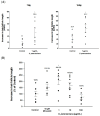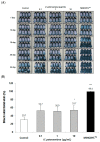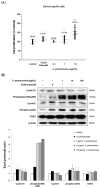Undariopsis peterseniana Promotes Hair Growth by the Activation of Wnt/β-Catenin and ERK Pathways
- PMID: 28475144
- PMCID: PMC5450536
- DOI: 10.3390/md15050130
Undariopsis peterseniana Promotes Hair Growth by the Activation of Wnt/β-Catenin and ERK Pathways
Abstract
In this study, we investigated the effect and mechanism of Undariopsis peterseniana, an edible brown alga, on hair growth. The treatment of vibrissa follicles with U. peterseniana extract ex vivo for 21 days significantly increased the hair-fiber lengths. The U. peterseniana extract also significantly accelerated anagen initiation in vivo. Moreover, we found that U. peterseniana extract was able to open the KATP channel, which may contribute to increased hair growth. The U. peterseniana extract decreased 5α-reductase activity and markedly increased the proliferation of dermal papilla cells, a central regulator of the hair cycle. The U. peterseniana extract increased the levels of cell cycle proteins, such as Cyclin D1, phospho(ser780)-pRB, Cyclin E, phospho-CDK2, and CDK2. The U. peterseniana extract also increased the phosphorylation of ERK and the levels of Wnt/β-catenin signaling proteins such as glycogen synthase kinase-3β (GSK-3β) and β-catenin. These results suggested that the U. peterseniana extract had the potential to influence hair growth by dermal papilla cells proliferation through the activation of the Wnt/β-catenin and ERK pathways. We isolated a principal of the U. peterseniana extract, which was subsequently identified as apo-9'-fucoxanthinone, a trichogenic compound. The results suggested that U. peterseniana extract may have a pivotal role in the treatment of alopecia.
Keywords: 5α-reductase; KATP channel; Undariopsis peterseniana; Wnt/β-catenin; apo-9′-fucoxanthinone; dermal papilla cell; hair growth.
Conflict of interest statement
The authors declare no conflicts of interest.
Figures







Similar articles
-
Promotion Effect of Apo-9'-fucoxanthinone from Sargassum muticum on Hair Growth via the Activation of Wnt/β-Catenin and VEGF-R2.Biol Pharm Bull. 2016;39(8):1273-83. doi: 10.1248/bpb.b16-00024. Biol Pharm Bull. 2016. PMID: 27476937
-
The promoting effect of Ishige sinicola on hair growth.Mar Drugs. 2013 May 24;11(6):1783-99. doi: 10.3390/md11061783. Mar Drugs. 2013. PMID: 23708185 Free PMC article.
-
Lactoferrin promotes hair growth in mice and increases dermal papilla cell proliferation through Erk/Akt and Wnt signaling pathways.Arch Dermatol Res. 2019 Jul;311(5):411-420. doi: 10.1007/s00403-019-01920-1. Epub 2019 Apr 20. Arch Dermatol Res. 2019. PMID: 31006055 Free PMC article.
-
Targeting of CXXC5 by a Competing Peptide Stimulates Hair Regrowth and Wound-Induced Hair Neogenesis.J Invest Dermatol. 2017 Nov;137(11):2260-2269. doi: 10.1016/j.jid.2017.04.038. Epub 2017 Jun 6. J Invest Dermatol. 2017. PMID: 28595998 Review.
-
Lagerstroemia indica extract regulates human hair dermal papilla cell growth and degeneration via modulation of β-catenin, Stat6, and TGF-β signaling pathway.J Cosmet Dermatol. 2022 Jul;21(7):2763-2773. doi: 10.1111/jocd.15081. Epub 2022 Jun 9. J Cosmet Dermatol. 2022. PMID: 35596731 Review.
Cited by
-
Twist1 Contributes to the Maintenance of Some Biological Properties of Dermal Papilla Cells in vitro by Forming a Complex With Tcf4 and β-Catenin.Front Cell Dev Biol. 2020 Aug 19;8:824. doi: 10.3389/fcell.2020.00824. eCollection 2020. Front Cell Dev Biol. 2020. PMID: 32974352 Free PMC article.
-
Regulation of Proliferation and Apoptosis of Hair Follicle Stem Cells by miR-145-5p in Yangtze River Delta White Goats.Genes (Basel). 2022 Oct 28;13(11):1973. doi: 10.3390/genes13111973. Genes (Basel). 2022. PMID: 36360210 Free PMC article.
-
HNG, A Humanin Analogue, Promotes Hair Growth by Inhibiting Anagen-to-Catagen Transition.Int J Mol Sci. 2020 Jun 26;21(12):4553. doi: 10.3390/ijms21124553. Int J Mol Sci. 2020. PMID: 32604799 Free PMC article.
-
The Potential Role of Nutraceuticals as an Adjuvant in Breast Cancer Patients to Prevent Hair Loss Induced by Endocrine Therapy.Nutrients. 2020 Nov 18;12(11):3537. doi: 10.3390/nu12113537. Nutrients. 2020. PMID: 33217935 Free PMC article. Review.
-
Comparative proteomic analysis of the telogen-to-anagen transition in cashmere goat secondary hair follicles.Front Vet Sci. 2025 Feb 25;12:1542682. doi: 10.3389/fvets.2025.1542682. eCollection 2025. Front Vet Sci. 2025. PMID: 40070920 Free PMC article.
References
-
- Kaufman K.D., Olsen E.A., Whiting D., Savin R., DeVillez R., Bergfeld W., Price V.H., Van Neste D., Roberts J.L., Hordinsky M., et al. Finasteride in the treatment of men with androgenetic alopecia. Finasteride male pattern hair loss study group. J. Am. Acad. Dermatol. 1998;39:578–589. doi: 10.1016/S0190-9622(98)70007-6. - DOI - PubMed
MeSH terms
Substances
LinkOut - more resources
Full Text Sources
Other Literature Sources
Research Materials
Miscellaneous

